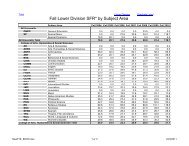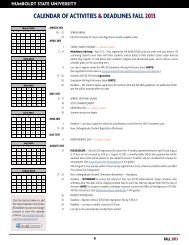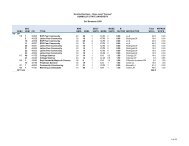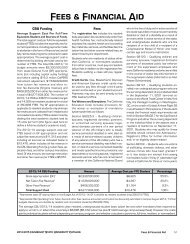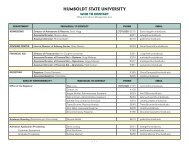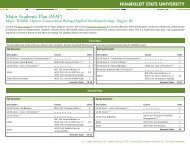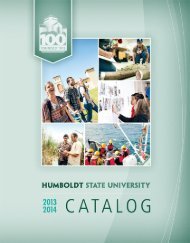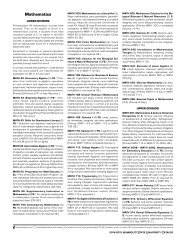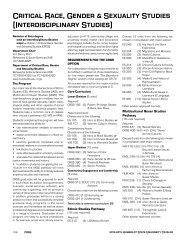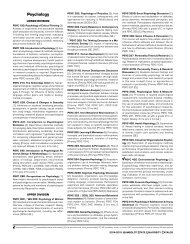2007-08 Academic Year - Humboldt State University
2007-08 Academic Year - Humboldt State University
2007-08 Academic Year - Humboldt State University
You also want an ePaper? Increase the reach of your titles
YUMPU automatically turns print PDFs into web optimized ePapers that Google loves.
Contact the university health educator at (707)<br />
826-5123 for more information.<br />
Many self-help groups meet both on campus and<br />
in the community. Check the bulletin board outside<br />
the health educator’s office and counseling center<br />
on the second floor of the Health Center for exact<br />
names, places, and times. There are many community<br />
resources (public, private nonprofit, and<br />
private for profit) available. Resources, both on<br />
and off campus, include:<br />
On-Campus:<br />
Counseling & Psychological<br />
Services.....................................................826-3236<br />
Student Health Center.............................826-3146<br />
Off-Campus:<br />
Alcoholics Anonymous.......... 442-0711 (24 hrs)<br />
Al-Anon and Al-Ateen ................................443-1419<br />
Alcohol/Drug Care<br />
Services (DETOX)...................................445-3869<br />
American Cancer Society.......................442-1436<br />
Codependents Anonymous....................445-3833<br />
Crossroads Residential<br />
Program....................................................445-<strong>08</strong>69<br />
<strong>Humboldt</strong> Alcohol Recovery<br />
Center........................................................443-4237<br />
Health Department Tobacco<br />
Education ..................................................268-2132<br />
Health Department Free &<br />
Anonymous HIV/AIDS<br />
Testing........................................................268-2132<br />
Healthy Moms..............................................441-5220<br />
<strong>Humboldt</strong> County Alcohol &<br />
Other Drug Programs.......................445-6250<br />
<strong>Humboldt</strong> Recovery Center...................443-4237<br />
<strong>Humboldt</strong> Women for Shelter..............444-9255<br />
24-hour Crisis Line..............................443-6042<br />
Mothers Against Drunk Driving...........443-5072<br />
Narcotics Anonymous..............................444-8645<br />
Open-Door Clinic Smoking<br />
Cessation..................................................826-8610<br />
PACE Program.............................................445-7444<br />
St. Joseph Hospital Family<br />
Recovery Services.................................445-9251<br />
Singing Trees Recovery Center............247-3334<br />
United Indian Health Services...............825-5000<br />
Health Risks Associated with<br />
Substance Abuse<br />
Substance abuse can cause extremely serious<br />
health and behavioral problems, including shortand<br />
long-term effects upon the body and mind. The<br />
physiological and psychological responses differ<br />
according to the chemical ingested. Although<br />
chronic health problems are associated with<br />
long-term substance abuse, acute and traumatic<br />
reactions can occur from one-time and moderate<br />
use.<br />
The health risks associated with each of five major<br />
classifications of controlled/illegal substances<br />
are summarized below. In general, alcohol and<br />
drugs are toxic to the body’s systems. In addition,<br />
contaminant poisonings often occur with illegal<br />
drug use, and mixing drugs, or using “counterfeit”<br />
substances, can also be lethal. Human Immunodeficiency<br />
Virus (HIV or AIDS), other sexually transmitted<br />
infections, rape, unwanted pregnancies,<br />
injuries, accidents, and violence can result from<br />
alcohol abuse or drug use. In addition, substance<br />
abuse impairs learning ability and performance.<br />
Acute health problems may include heart attack,<br />
stroke, and sudden death, which, in the case of<br />
drugs such as cocaine, can be triggered by firsttime<br />
use. Long lasting health effects of drugs<br />
and alcohol may include disruption of normal<br />
heart rhythm, high blood pressure, blood vessel<br />
leaks in the brain, destruction of brain cells and<br />
permanent memory loss, infertility, impotency, immune<br />
system impairment, kidney failure, cirrhosis<br />
of the liver, and pulmonary (lung) damage. Drug<br />
use during pregnancy may result in miscarriage,<br />
fetal damage and birth defects causing hyperactivity,<br />
neurological abnormalities, developmental<br />
difficulties, and infant death.<br />
Alcohol. As many as 360,000 of the nation’s 12<br />
million undergraduates will ultimately die from<br />
alcohol-related causes while in school. This is more<br />
than the number who will get MAs and PhDs combined.<br />
Nearly half of all college students binge drink<br />
(binge drinking is defined as five or more drinks at<br />
a time for men, four or more drinks for women).<br />
On campuses where binge drinking is rampant<br />
(where more than 70% of students binge drink),<br />
the vast majority of students have experienced<br />
one or more problems as a result of their peers’<br />
binge drinking. These problems include physical<br />
assault, sexual harassment, and impaired sleep<br />
and study time. Alcohol on college campuses is a<br />
factor in 40% of all academic problems and 28%<br />
of all dropouts.<br />
Long-term abuse of alcohol results in ulcers,<br />
gastritis, pancreatitis, liver disease, hepatitis,<br />
and cirrhosis, and is associated with cancers of<br />
the digestive tract. Chronic heavy consumption<br />
can lead to stroke, hypertension, heart disease,<br />
anemia, susceptibility to tuberculosis, gastrointestinal<br />
bleeding, impotence and fertility loss. Episodic<br />
binge drinking can cause toxic reactions leading<br />
to death when large amounts are consumed or<br />
when alcohol is combined with other drugs. The<br />
most common negative health consequences<br />
from occasional drinking are trauma-related (accidents<br />
and violence), and involve both the drinker<br />
and nondrinking victims.<br />
Sources: Wechsler, Henry, et al. “Health and<br />
Behavioral Consequences of Binge Drinking in<br />
College,” Journal of the American Medical<br />
Association, Vol 272, Number 21 1994), p<br />
1672-1677; Eigan, Lewis, “Alcohol Practices,<br />
Policies and Potentials of American Colleges<br />
and Universities,” An OSAP White Paper, Office<br />
for Substance Abuse Prevention, Rockville, MD,<br />
February 1991; Anderson, David, “Breaking the<br />
Tradition on College Campuses: Reducing Drug<br />
and Alcohol Misuse,” George Mason <strong>University</strong>,<br />
Fairfax, VA 1994.)<br />
Other Depressants. These drugs include narcotics<br />
(for example, opium, heroin, morphine,<br />
codeine, and synthetic opiates) and sedative-hypnotics<br />
and antianxiety medications (for example,<br />
Nembutal, Seconal, Quaalude, Miltown, Equanil). All<br />
are central nervous depressants that slow down<br />
physical and psychological responses. The most<br />
serious risk is toxic reaction, or overdose, which<br />
causes death when respiratory, cardiac, and<br />
circulatory systems slow down and cease to function.<br />
Sedatives and antianxiety drugs can cause<br />
temporary psychosis, hallucinations, paranoid<br />
delusions, interference with short-term memory,<br />
impaired judgment and motor performance,<br />
increased angry outbursts, and permanent neurological<br />
damage.<br />
Stimulants. These drugs include amphetamines,<br />
methamphetamines, and cocaine (crack). Stimulant<br />
drugs are exceedingly dangerous to both<br />
physical and mental health. Physical complications<br />
include heart attack, stroke, permanent brain<br />
damage, fatal heart rhythm abnormalities, convulsions,<br />
and physical exhaustion. Psychological<br />
complications include psychosis, paranoia anxiety,<br />
violent behavior, and depression that may lead<br />
to suicide. Injection of these drugs may lead to<br />
serious infections, including AIDS.<br />
Hallucinogens. These drugs include mescaline,<br />
psilocybin, LSD, MDMA (ecstasy), and various<br />
mushrooms. They involve health risks such as<br />
panic reactions, flashbacks, toxic reactions (overdose),<br />
hallucinations, and death. Psychological<br />
states induced can include paranoia and psychosis.<br />
Misidentification of mushrooms can lead<br />
to serious or fatal illness.<br />
PCP. PCP users often become violent and oblivious<br />
to pain, leading to serious injuries to themselves<br />
and others.<br />
Marijuana. This drug simultaneously creates<br />
physical symptoms akin to both depressants<br />
(relaxation, sleepiness) and stimulants (increased<br />
respiratory/heart rates). Chronic marijuana<br />
smoking results in respiratory difficulties, bronchitis,<br />
and probably both emphysema and lung<br />
cancer. Episodic use can cause panic reactions,<br />
flashbacks, and depression. Psychosis may occur<br />
in susceptible individuals, and severe toxic reactions<br />
may result from ingestion of large quantities.<br />
Some of the most serious consequences of<br />
marijuana use result when decreased judgment,<br />
impaired perceptions and motor functions, and<br />
inability to carry out multistep tasks lead to motor<br />
vehicle crashes and other trauma.<br />
Institutional & Financial Assistance<br />
Information<br />
The following information concerning student<br />
financial assistance may be obtained from the<br />
Financial Aid Office, SBS 241, (707) 826-4321:<br />
1. A description of the federal, state, institutional,<br />
local, and private student financial assistance<br />
programs available to students who enroll at<br />
<strong>Humboldt</strong> <strong>State</strong> <strong>University</strong>.<br />
2. For each aid program, a description of<br />
procedures and forms by which students apply<br />
for assistance, student eligibility requirements,<br />
criteria for selecting recipients from the group<br />
of eligible applicants, and criteria for determining<br />
the amount of a student's award;<br />
3. A description of the rights and responsibilities<br />
of students receiving financial assistance, including<br />
federal Title IV student assistance programs,<br />
<strong>2007</strong>-20<strong>08</strong> <strong>Humboldt</strong> <strong>State</strong> <strong>University</strong> Catalog<br />
The Fine Print<br />
279



